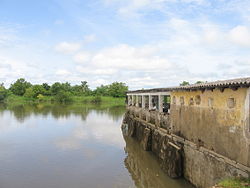Bafatá Region
| Bafatá | |
|---|---|
| Region | |
 |
|
 Bafatá Region |
|
| Country | Guinea-Bissau |
| Seat | Bafatá |
| Sectors | Bafatá, Bambadinca, Contuboel, Galomaro, Gamamundo, Xitole |
| Area | |
| • Total | 5,981.1 km2 (2,309.3 sq mi) |
| Population (2009) | |
| • Total | 225,516 |
| • Density | 38/km2 (98/sq mi) |
| ISO 3166 code | GW-BA |
Coordinates: 12°10′N 14°45′W / 12.167°N 14.750°W
Bafatá is a region in north-central Guinea-Bissau and its capital is Bafatá. It is an inland region covered with Savannah or light Savannah woodland and receives an annual rainfall of more than 2,000 mm (79 in).
As of 2009, the total population of the region was 200,884, with the urban population being 38,850 and rural being 162,034. The sex ratio of the region is 94 females for every hundred males. The total resident population in the region is 269,840. As of 2009, the net activity rate was 60.48 per cent, proportion of employed labour force was 39.90 per cent, proportion of labour force was 75.30 and the proportion of potentially active population was 39.90 per cent. The absolute poverty rate, people earning less than $2 a day, in the region stood at 72.4 per cent, with a regional contribution of 13.6 per cent to the national poverty totals.
Gabu is an inland region and all the inland regions have a maximum elevation of 300 m (980 ft). The internal region has plains, which are interspersed with rias. There are lot of meandering rivers, many of them forming estuaries in the coastal regions. The principal river, Corubal River, flows through the region. The climate is hot and tropical and the region has two seasons. The onset of summer is from December to May with April - May period having temperature ranges from 20 °C (68 °F) to 30 °C (86 °F). The rainy season is usually from May to November. The region receives an average rainfall of around 1,000 mm (39 in) compared to the coastal regions, which receive 2,000 mm (79 in). The internal regions are covered with Savannah or light Savannah woodland.
As of 2009, the total population of the region was 200,884, with the urban population being 38,850 and rural being 162,034. The sex ratio of the region is 94 females for every hundred males. The total resident population in the region is 269,840. The total agricultural population in the region is 77,682. The average number of household in the region is 11.0 and the density of the population is 33.6 sq. km. The intercensal rate of average annual growth (adjusted data) is 2.05 per cent. The non-agricultural population in the country is 123,202. The total number of households per capita in the region is 25,031. The fraction of Christians in the region is 6.8 per cent, Muslims is 77.10 per cent, animists is 3.90 per cent, not detailed was 11.30 per cent and people following no religion was 0.9 per cent.
...
Wikipedia
